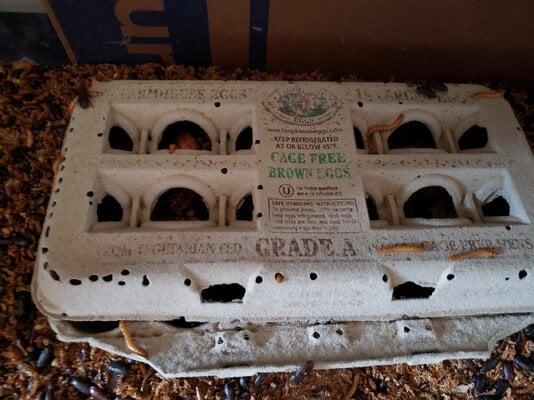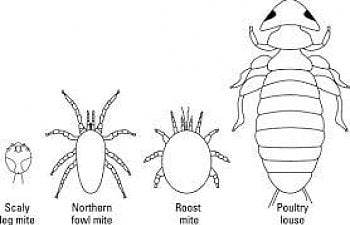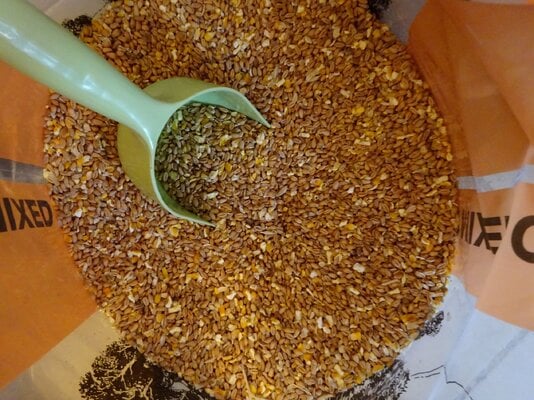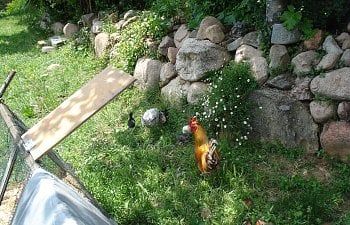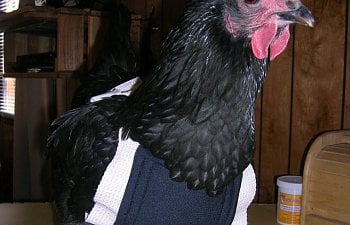Solid article, good pictures of the stages of development. I'm planning to start a mealworm farm. I don't have access to a place to order them from, but I suspect theres a whole bunch in my compost pile where I could harvest them.
Navigation
Install the app
How to install the app on iOS
Follow along with the video below to see how to install our site as a web app on your home screen.
Note: This feature may not be available in some browsers.
More options
You are using an out of date browser. It may not display this or other websites correctly.
You should upgrade or use an alternative browser.
You should upgrade or use an alternative browser.
Reviews by TropicalChickies
Filters
Show only:
Loading…
- TropicalChickies
- 5.00 star(s)
notabitail
Thank you:). If you have native mealworms there might be some there. Good luck!
- TropicalChickies
- 5.00 star(s)
Excellent and comprehensive article with practical and actionable advice. Thank you for mentioning sticktight fleas, usually found in warmer and wetter zones like the tropics and subtropics (where I live). They can be easy to confuse with mites but have a different life cycle so it's important to make that distinction. Thanks for writing this up.
- TropicalChickies
- 5.00 star(s)
Thanks for researching and writing this article, and including the references which I am reading with interest. It's very timely for me and I plan to put it in to practice starting now. I have a few questions below, but first, here is why I'm making the transition.
I've been thinking for a long time about making a homemade feed mix for my chickens. The biggest obstacle that's been stopping me is finding the time to research the different foods readily available here, their nutritional contents, and devising a formula – or formulas – based on my findings. It's just so darn easy to buy the bag of layer or chick crumble. And cheap – 40 cents per pound. We don't have enough help as it is running our farm and various projects as it is, and money is always an issue. But… I've received multiple signs that I need to find the time somewhere and stop buying this stuff.
The signs? Nothing from the ether, just the crappy fact that two out of the last three sacks of crumble I bought went moldy and I had to toss it. I only buy 20lb sacks, I keep the crumble in an airtight container, I and always use it within a month. So that means it's coming from the feed store already almost spoiled. I'd rather spend time than waste money on spoiled feed.
Where we live (rural Ecuador, rainforest climate) it's not like I have choices of feed brands, designer this or organic that. There's one or two big companies distributing animal feeds, one kind of feed for layers, one for chicks, and that's it. The layer and chick feed comes in unmarked plain sacks, no date, and the only way to find out what's in it is to ask the store proprietor if you can please look at the label on the enormous sack from the manufacturer in the warehouse. So I know the feed is a pretty typical commercial mix: wheat, soy, maize, sunflower oil, and a bunch of vitamin additives, 18% protein minimum. Maybe it's average as feeds go, but if I can't get it fresh enough to use without potentially poisoning my birds, that's the game changer right there.
Another reason: anytime I have a chicken who is feeling a little off, the first thing they do is reject the commercial feed. I'm not talking about dying birds. I've successfully treated cases of mild respiratory illness, sour crop, and bumblefoot, and when chickens are recovering, all they want is the scrambled egg, sardines, and wholesome carbs like quinoa or sweet potato that I give them. It's a chore to get them to go back to eating commercial feed again, and that tells me it's really not what they want or need.
Furthermore, my chickens free range all day every day in orchards, forest, and grassy areas. There's all sorts of wild berries, cultivated fruits, grasses, and native groundcover plants. They nibble at whatever looks good to them. So I can assume they are supplementing their diet already with foraging.
Besides, I've wanted to make a change for personal reasons. I just don't feel good feeding them that stuff. It feels like a convenient cop out, and that's not congruent with our lifestyle out here at all. Neither wheat nor soy are grown in Ecuador so what's in this feed is either GMO loaded crap from Empire USA or linked to Amazon deforestation in Brazil, or both. Lordy. And here I am talking about the importance of rainforests and food sovereignty and locally produced food and the evils of globalization and yadda yadda, but I've been buying this stuff for my chickens, whom I like better than most people. No wonder I feel like a total turd dishing it out to them.
I tossed the moldy feed today and have no plans to go into town for a few days, but the chickens needed to eat. So I just cooked up a pot of rice, quinoa, sweet potato, amaranth, flax seeds, lentils and added half a cup of yellow split pea flour to boost the protein. I added some fresh grated turmeric and ginger root from the garden. Maybe it's not perfect, but I felt good making it and the chickens loved it.

I've been giving them a big can of mackerel or sardines once a week, or making a stew with meaty beef bones, cassava and quinoa. And their reaction when I dish out something like that makes it obvious they are clamoring for something else than the crumble.
Ok, rant over. On to your article and my questions for you. I see that your personal studies led you to use wheat as a base ingredient. For reasons already mentioned, I don't want to use wheat. If I'm going to do this, I want to do it right, meaning I use what we grow on the farm and what's readily available from local sources.
I'd appreciate it if you could look at these lists of possible ingredients and advise me which ones would be your top picks for a homemade feed.
If I could devise a mix based on "free" ingredients (what we grow) from List 1 combined with ingredients from the second two lists, I could come up with something for the same cost as commercial feed.
We grow four excellent carbohydrate sources, each with different vitamin, mineral and fiber content.
List 1
Cassava (manioc). Big starchy tubers (not related to potato). Very low protein. High fiber. Some mineral content. The chickens love it. A lot of folks around here feed their chickens cassava, it grows so easily and is hugely productive. But is so low in protein, I wouldn't use it alone.
Camote. A tropical sweet potato. Less sugar than temperate sweet potatoes. Moderate protein. High fiber, vitamin and mineral content.
Taro. Small starchy roots. Not related to potato. Low protein. Good mineral content. Reportedly anti- inflammatory.
Plantains. Similar to bananas, but bigger with less sugar.* High in B vitamins and potassium. Can be consumed raw when yellow (ripe) or cooked when green.
All of these would require cooking to neutralize oxalates and make them more digestible. But I figure I could make a big batch every three days and by days two and three it would be lightly fermented. That's how Kichwa people get chicha (fermented drinks) started (and by adding their saliva, btw).
*Note: I'm careful with my flock eating bananas. I know they are excellent sources of nutrition, but occasionally they have gotten into an entire bunch that fell in the fruit orchard and ended up with a sour crop from eating dozens of rotting bananas, peels and all. So I'm more comfortable with using cooked green plantains because they are much lower in sugar or moderately ripe plantains raw.
List 2
Ingredients Locally available (at 50 - 60 cents per lb):
Barley
Cracked maize
Rolled oats
Rice*
Lentils
Black eyed peas (cowpeas)
Dried peas
Lupine
*I didn't think rice was very nutritious, but turns out it has a lot of benefits for chickens. My group prefers it cooked.
https://learnpoultry.com/chickens-eat-rice/
List 3
More Ingredients Locally available (at about $1 per lb):
These more costly ingredients I could add in smaller amounts to make the mix more nutritious.
Quinoa* (moderate protein, complete amino acid profile, )
Amaranth* (high protein, minerals)
Flax seed* (high protein, fat, minerals)
Chia seed* (similar to flax in composition)
Yellow split pea flour** (high protein)
Fava bean flour**(high protein)
*Regarding these ingredients, they are extremely high in some minerals. See this breakdown on amaranth for example.
**These flours are easy to use by adding water to make a paste and mixing it in with a grain mix or mash to up the protein.

Question: I notice that you recommend using lentils sparingly because they have a lot of iron. Are there other minerals that chickens should not get in excess?
Question: How would I formulate the mix? I was thinking perhaps to research the nutritional contents of each food per 100g and try different combinations that would have a minimum protein and fat content and a broad array of vitamins and minerals. What's the easiest way to figure this out? Or is this calculation not even necessary?
Question: Seeing how some of these ingredients (especially the ones we grow) and the hard seeds (like quinoa and amaranth) require cooking, while others only need soaking and fermenting, I figure I could devise two "formulas" –
I would still plan on giving them some sardines and/or meat weekly as a "real treat."
I really appreciate any of your expertise with this. I'm done with this commercially manufactured stuff. My birds deserve better.
Thank you very much!
I've been thinking for a long time about making a homemade feed mix for my chickens. The biggest obstacle that's been stopping me is finding the time to research the different foods readily available here, their nutritional contents, and devising a formula – or formulas – based on my findings. It's just so darn easy to buy the bag of layer or chick crumble. And cheap – 40 cents per pound. We don't have enough help as it is running our farm and various projects as it is, and money is always an issue. But… I've received multiple signs that I need to find the time somewhere and stop buying this stuff.
The signs? Nothing from the ether, just the crappy fact that two out of the last three sacks of crumble I bought went moldy and I had to toss it. I only buy 20lb sacks, I keep the crumble in an airtight container, I and always use it within a month. So that means it's coming from the feed store already almost spoiled. I'd rather spend time than waste money on spoiled feed.
Where we live (rural Ecuador, rainforest climate) it's not like I have choices of feed brands, designer this or organic that. There's one or two big companies distributing animal feeds, one kind of feed for layers, one for chicks, and that's it. The layer and chick feed comes in unmarked plain sacks, no date, and the only way to find out what's in it is to ask the store proprietor if you can please look at the label on the enormous sack from the manufacturer in the warehouse. So I know the feed is a pretty typical commercial mix: wheat, soy, maize, sunflower oil, and a bunch of vitamin additives, 18% protein minimum. Maybe it's average as feeds go, but if I can't get it fresh enough to use without potentially poisoning my birds, that's the game changer right there.
Another reason: anytime I have a chicken who is feeling a little off, the first thing they do is reject the commercial feed. I'm not talking about dying birds. I've successfully treated cases of mild respiratory illness, sour crop, and bumblefoot, and when chickens are recovering, all they want is the scrambled egg, sardines, and wholesome carbs like quinoa or sweet potato that I give them. It's a chore to get them to go back to eating commercial feed again, and that tells me it's really not what they want or need.
Furthermore, my chickens free range all day every day in orchards, forest, and grassy areas. There's all sorts of wild berries, cultivated fruits, grasses, and native groundcover plants. They nibble at whatever looks good to them. So I can assume they are supplementing their diet already with foraging.
Besides, I've wanted to make a change for personal reasons. I just don't feel good feeding them that stuff. It feels like a convenient cop out, and that's not congruent with our lifestyle out here at all. Neither wheat nor soy are grown in Ecuador so what's in this feed is either GMO loaded crap from Empire USA or linked to Amazon deforestation in Brazil, or both. Lordy. And here I am talking about the importance of rainforests and food sovereignty and locally produced food and the evils of globalization and yadda yadda, but I've been buying this stuff for my chickens, whom I like better than most people. No wonder I feel like a total turd dishing it out to them.
I tossed the moldy feed today and have no plans to go into town for a few days, but the chickens needed to eat. So I just cooked up a pot of rice, quinoa, sweet potato, amaranth, flax seeds, lentils and added half a cup of yellow split pea flour to boost the protein. I added some fresh grated turmeric and ginger root from the garden. Maybe it's not perfect, but I felt good making it and the chickens loved it.
I've been giving them a big can of mackerel or sardines once a week, or making a stew with meaty beef bones, cassava and quinoa. And their reaction when I dish out something like that makes it obvious they are clamoring for something else than the crumble.
Ok, rant over. On to your article and my questions for you. I see that your personal studies led you to use wheat as a base ingredient. For reasons already mentioned, I don't want to use wheat. If I'm going to do this, I want to do it right, meaning I use what we grow on the farm and what's readily available from local sources.
I'd appreciate it if you could look at these lists of possible ingredients and advise me which ones would be your top picks for a homemade feed.
If I could devise a mix based on "free" ingredients (what we grow) from List 1 combined with ingredients from the second two lists, I could come up with something for the same cost as commercial feed.
We grow four excellent carbohydrate sources, each with different vitamin, mineral and fiber content.
List 1
Cassava (manioc). Big starchy tubers (not related to potato). Very low protein. High fiber. Some mineral content. The chickens love it. A lot of folks around here feed their chickens cassava, it grows so easily and is hugely productive. But is so low in protein, I wouldn't use it alone.
Camote. A tropical sweet potato. Less sugar than temperate sweet potatoes. Moderate protein. High fiber, vitamin and mineral content.
Taro. Small starchy roots. Not related to potato. Low protein. Good mineral content. Reportedly anti- inflammatory.
Plantains. Similar to bananas, but bigger with less sugar.* High in B vitamins and potassium. Can be consumed raw when yellow (ripe) or cooked when green.
All of these would require cooking to neutralize oxalates and make them more digestible. But I figure I could make a big batch every three days and by days two and three it would be lightly fermented. That's how Kichwa people get chicha (fermented drinks) started (and by adding their saliva, btw).
*Note: I'm careful with my flock eating bananas. I know they are excellent sources of nutrition, but occasionally they have gotten into an entire bunch that fell in the fruit orchard and ended up with a sour crop from eating dozens of rotting bananas, peels and all. So I'm more comfortable with using cooked green plantains because they are much lower in sugar or moderately ripe plantains raw.
List 2
Ingredients Locally available (at 50 - 60 cents per lb):
Barley
Cracked maize
Rolled oats
Rice*
Lentils
Black eyed peas (cowpeas)
Dried peas
Lupine
*I didn't think rice was very nutritious, but turns out it has a lot of benefits for chickens. My group prefers it cooked.
https://learnpoultry.com/chickens-eat-rice/
List 3
More Ingredients Locally available (at about $1 per lb):
These more costly ingredients I could add in smaller amounts to make the mix more nutritious.
Quinoa* (moderate protein, complete amino acid profile, )
Amaranth* (high protein, minerals)
Flax seed* (high protein, fat, minerals)
Chia seed* (similar to flax in composition)
Yellow split pea flour** (high protein)
Fava bean flour**(high protein)
*Regarding these ingredients, they are extremely high in some minerals. See this breakdown on amaranth for example.
**These flours are easy to use by adding water to make a paste and mixing it in with a grain mix or mash to up the protein.
Question: I notice that you recommend using lentils sparingly because they have a lot of iron. Are there other minerals that chickens should not get in excess?
Question: How would I formulate the mix? I was thinking perhaps to research the nutritional contents of each food per 100g and try different combinations that would have a minimum protein and fat content and a broad array of vitamins and minerals. What's the easiest way to figure this out? Or is this calculation not even necessary?
Question: Seeing how some of these ingredients (especially the ones we grow) and the hard seeds (like quinoa and amaranth) require cooking, while others only need soaking and fermenting, I figure I could devise two "formulas" –
- A cooked mash of cassava, camote, plantain etc with peas or lentils and seeds added. The tubers, quinoa, and amaranth all have equal cooking times so could be easily prepared.
- A soaked fermented mix of oats, barley, and maize with peas and seeds added.
I would still plan on giving them some sardines and/or meat weekly as a "real treat."
I really appreciate any of your expertise with this. I'm done with this commercially manufactured stuff. My birds deserve better.
Thank you very much!
Last edited:
Perris
Wow! Go TropicalChickies! I think you only really need the confidence to fly with this; it's clear you've already done lots of research, and some practice, and there's little to nothing I can add on foods local to you: You already know them better than I do. I would use all of what you have of these list items when you have it fresh and in plenty; diversity is good. And I guess the forage is excellent.
On specifics, "by days two and three it would be lightly fermented. That's how Kichwa people get chicha (fermented drinks) started (and by adding their saliva, btw)" note that fermentation that leads to alcohol involves yeasts, rather than bacteria, and I don't know how good that may or may not be for their microbiomes; I've not researched it as yet.
Minerals to beware: it's copper and manganese as well as iron to be wary of with lentils. The 1994 book on Nutrient Requirements of Poultry chapter 8 is specifically on the toxicity of certain inorganic elements.
I don't have 'a' formula as such, and I don't think one is necessary or desirable because one size does not fit all. I have a base of grains and peas and mealworms/ sardines - and you have local equivalents - that I treat as a guide not a rule, and the key thing about what else I add is that it is fresh and that it changes, because it's seasonal or because they haven't had it recently. Again variety and diversity are my watchwords.
Foods that need cooking and foods that need fermenting do need to be prepared separately even if served together, and that does sound like a good plan. I too sometimes add for example a little fennel seed, brown mustard seed or suchlike to the ferment; they like fennel but most don't like the mustard. Typically I arrange the cooked foods by preparing extra when we are eating it, and put some aside for the next chicken meal.
Thank you so much for your review. What you say at the start will chime with a lot of people, I think. And maybe you would consider keeping notes to write an article in months to come on how the transition goes for you and your flock?
On specifics, "by days two and three it would be lightly fermented. That's how Kichwa people get chicha (fermented drinks) started (and by adding their saliva, btw)" note that fermentation that leads to alcohol involves yeasts, rather than bacteria, and I don't know how good that may or may not be for their microbiomes; I've not researched it as yet.
Minerals to beware: it's copper and manganese as well as iron to be wary of with lentils. The 1994 book on Nutrient Requirements of Poultry chapter 8 is specifically on the toxicity of certain inorganic elements.
I don't have 'a' formula as such, and I don't think one is necessary or desirable because one size does not fit all. I have a base of grains and peas and mealworms/ sardines - and you have local equivalents - that I treat as a guide not a rule, and the key thing about what else I add is that it is fresh and that it changes, because it's seasonal or because they haven't had it recently. Again variety and diversity are my watchwords.
Foods that need cooking and foods that need fermenting do need to be prepared separately even if served together, and that does sound like a good plan. I too sometimes add for example a little fennel seed, brown mustard seed or suchlike to the ferment; they like fennel but most don't like the mustard. Typically I arrange the cooked foods by preparing extra when we are eating it, and put some aside for the next chicken meal.
Thank you so much for your review. What you say at the start will chime with a lot of people, I think. And maybe you would consider keeping notes to write an article in months to come on how the transition goes for you and your flock?
- TropicalChickies
- 5.00 star(s)
Solid common sense advice with real world examples to back it up. I just integrated a five month old pullet named Frida into my flock very easily by doing pretty much exactly what you recommend here. It only took 3 days of having her in an wide mesh screened area to eat and relax by herself -- while she could still see the flock around her and they could see her. Last night she walked into the coop to roost by herself and no one hassled her. It helps that my senior hen Cleo is too boss to be bothered with harassing her and pretty much signals to the others to leave her be.
I agree that having an enclosed area where newbies can get on their feet is essential. Good for birds who are injured or feeling a bit down as well.
I agree that having an enclosed area where newbies can get on their feet is essential. Good for birds who are injured or feeling a bit down as well.
- TropicalChickies
- 5.00 star(s)
This was interesting informative, inspiring, and very encouraging. I'm relatively new to hen keeping (4 years now) and completely new to roosters (I have two 5 month old cockerels who hatched at the same time here on the farm -- with probable but diluted gamefowl genetics. Yikes). But I'm fascinated with these animals and their complexities. I've learned how to treat most of the common problems competently. I take the time to observe and observing brings me great inner peace.
So given what I've read here about the tribe dynamics, I'm encouraged about the prospects for my two boys being able to live here, together but apart, with their own tribes. I've already seen how my little flock is naturally dividing itself between the hens who have been successfully claimed by the faster-maturing cockerel, and the others who are not so easily charmed showing a tolerance-bordering-on-friendship for the other one. I've mulled over the idea of creating a second space where the second cockerel could bond with a tribe of his own, and this article shows me that I could be on a good track with that.
Given that the chickens here already free roam and roost in their coop voluntarily, and I have a multi-acre land with trees orchards in a jungle environment (the Ecuador cloud forest), I can't think of a better place to carry on a similar multi-coop set up and observation experiment as you have done here.
It had also crossed my mind when reading advice like "You need at least 12 hens to 1 rooster" that this must be a result of keeping the birds somehow confined. Because you wouldn't find those ratios in a natural setting with jungle fowl. The way you've presented your observations just makes more intuitive sense with free roaming birds.
Thank you for the insights. I'm encouraged that I won't have to eliminate one of these handsome fellas.
Oh! And the part about the herding shuffle made me smile. Paco, the faster maturing cockerel, has been doing this to me every morning when I walk out to the feed area. Maybe he thinks I'm going to eat breakfast with them! Anyway, it didn't feel like aggression, but I was wondering what on earth he was doing... Thanks!
So given what I've read here about the tribe dynamics, I'm encouraged about the prospects for my two boys being able to live here, together but apart, with their own tribes. I've already seen how my little flock is naturally dividing itself between the hens who have been successfully claimed by the faster-maturing cockerel, and the others who are not so easily charmed showing a tolerance-bordering-on-friendship for the other one. I've mulled over the idea of creating a second space where the second cockerel could bond with a tribe of his own, and this article shows me that I could be on a good track with that.
Given that the chickens here already free roam and roost in their coop voluntarily, and I have a multi-acre land with trees orchards in a jungle environment (the Ecuador cloud forest), I can't think of a better place to carry on a similar multi-coop set up and observation experiment as you have done here.
It had also crossed my mind when reading advice like "You need at least 12 hens to 1 rooster" that this must be a result of keeping the birds somehow confined. Because you wouldn't find those ratios in a natural setting with jungle fowl. The way you've presented your observations just makes more intuitive sense with free roaming birds.
Thank you for the insights. I'm encouraged that I won't have to eliminate one of these handsome fellas.
Oh! And the part about the herding shuffle made me smile. Paco, the faster maturing cockerel, has been doing this to me every morning when I walk out to the feed area. Maybe he thinks I'm going to eat breakfast with them! Anyway, it didn't feel like aggression, but I was wondering what on earth he was doing... Thanks!
Shadrach
I'm pleased you found the article informative. It reads like you have a close to perfect opportunity to helo establish a couple of tribes. I found I needed to be one coop ahead of the current tribe occupancy. That will give you a spare should someone get sick or go broody or a rescue decides to make your place it's home. In your climate you certainly don't need anything elaborate. The longer the males are housed together the higher the chances are that they will fall out and fight.
- TropicalChickies
- 5.00 star(s)
Very useful and informative article written with compassion
×

